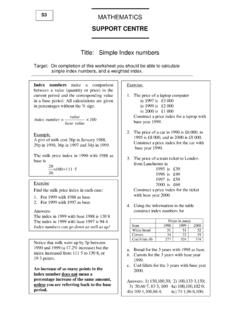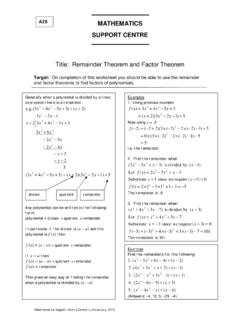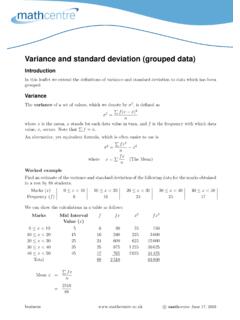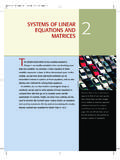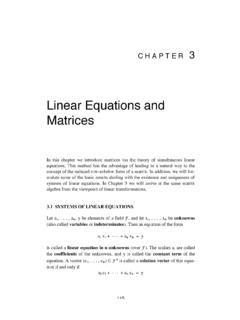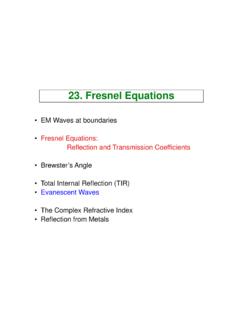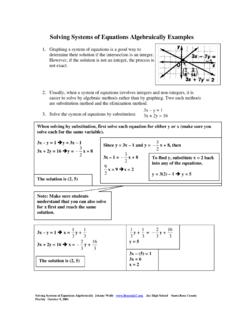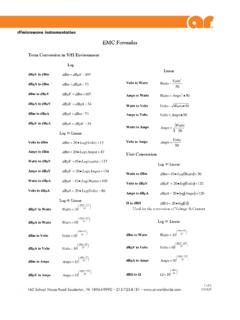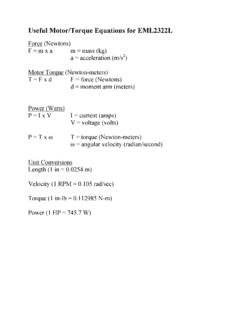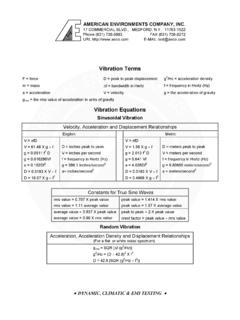Transcription of Cubic equations
1 Cubic equationsA Cubic equation has the formax3+bx2+cx+d= 0 wherea =0 All Cubic equations have either one real root, or three real roots. In this unit we explore whythis is we look at how Cubic equations can be solve dby spotting factors an dusing a metho dcalle dsynthetic division. Finally we will see how graphs can help us locate order to master the techniques explained here it is vital that you undertake plenty of practiceexercises so that they become secon reading this text, and/or viewing the video tutorial on this topic, you should be able to: explain why Cubic equations possess either one real root or three real roots use synthetic division to locate roots when one root is known fin dapproximate solutions by drawing a equations an dthe nature of their Cubic graphs to solve Cubic equations101c mathcentreAugust7,20031.
2 IntroductionIn this unit we explain what is meant by a Cubic equation an dhow such an equation can besolved. The general strategy for solving a Cubic equation is to reduce it to a quadratic equation,an dthen solve the qua dratic by the usual means, either by factorising or using the Cubic equations and the nature of their rootsA Cubic equation has the formax3+bx2+cx+d=0It must have the term inx3or it woul dnot be Cubic (an dsoa = 0), but any or all ofb,canddcan be zero. For instance,x3 6x2+11x 6=0,4x3+57=0,x3+9x=0are all Cubic as a quadratic equation may have two real roots, so a Cubic equation has possibly unlike a quadratic equation which may have no real solution, a Cubic equation always hasat least one real root. We will see why this is the case later. If a Cubic does have three roots, twoor even all three of them may be repeated.
3 This gives us four possibilities which are illustratedin the following we wish to solve the equationx3 6x2+11x 6=0 This equation can be factorise dto give(x 1)(x 2)(x 3)=0 This equation has three real roots, all different - the solutions arex=1,x= 2 andx= Figure 1 we show the graph ofy=x3 6x2+11x 1. The graph ofy=x3 6x2+11x that it starts low down on the left, because asxgets large an dnegative so doesx3andit finishes higher to the right because asxgets large an dpositive so doesx3. The curve crossesthex-axis three times, once wherex= 1, once wherex= 2 an donce wherex= 3. This givesus our three separate mathcentreAugust7,20032 ExampleSuppose we wish to solve the equationx3 5x2+8x 4= equation can be factorise dto give(x 1)(x 2)2=0In this case we do have three real roots but two of them are the same because of the term (x 2) we only have two distinct solutions.
4 Figure 2 shows a graph ofy=x3 5x2+8x 2. The graph ofy=x3 5x2+8x the curve starts low to the left an dgoes high to the right. It crosses thex-axis once andthen just touches it atx= 2. So we have our two rootsx= 1 andx= we wish to solve the equationx3 3x2+3x 1= equation can be factorise dto give(x 1)3=0So although there are three factors, they are all the same an dwe only have a single solutionx= 1. The corresponding curve isy=x3 3x2+3x 1 an dis shown in Figure 3. The graph ofy=x3 3x2+3x mathcentreAugust7,2003As with all the cubics we have seen so far, it starts low down on the left and goes high up tothe right. Notice that the curve does cross thex-axis at the pointx= 1 but thex-axis is alsoa tangent to the curve at this point. This is indicative of the fact that there are three we wish to solve the equationx3+x2+x 3= equation can be factorise dto give(x 1)(x2+2x+3)=0 The quadraticx2+2x+ 3 = 0 has no real solutions, so the only solution to the Cubic equationis obtaine dby puttingx 1 = 0, giving the single real solutionx= graphy=x3+x2+x 3 is shown in Figure 4.
5 The graph ofy=x3+x2+x can see that the graph crosses thex-axis in one place these graphs you can see why a Cubic equation always has at least one real root. Thegraph either starts large an dnegative an dfinishes large an dpositive (when the coefficient ofx3is positive), or it will start large an dpositive an dfinish off large an dnegative (when thecoefficient ofx3is negative).The graph of a cubicmustcross thex-axis at least once giving you at least one real root. So,any problem you get that involves solving a Cubic equation will have a real the real roots of the following Cubic equations - if a root is repeate dsay how ) (x+ 1)(x 2)(x 3) = 0 b) (x+ 1)(x2 12x+ 20) = 0 c) (x 3)2(x+4)=0d)(x+ 2)(x2+6x+ 10) = 0 e) (x+ 2)(x2+7x+10)=0 f) (x 5)(x2 10x+25)=0c mathcentreAugust7,200343.
6 Solving Cubic equationsNow let us move on to the solution of Cubic equations . Like a quadratic, a Cubic should alwaysbe re-arrange dinto its stan dar dform, in this caseax3+bx2+cx+d=0 The equationx2+4x 1=6xis a Cubic , though it is not written in the stan dar dform. We nee dto multiply through byx,giving usx3+4x2 x=6an dthen we subtract 6 from both si des, giving usx3+4x2 x 6=0 This is now in the standard formWhen solving cubics it helps if you know one root to start we wish to solvex3 5x2 2x+24=0given thatx= 2 is a is a theorem calle dtheFactorTheoremwhich we do not prove here. It states that ifx= 2 is a solution of this equation, thenx+2 is a factor of this whole expression. This meansthatx3 5x2 2x+ 24 = 0 can be written in the form(x+2)(x2+ax+b)=0whereaandbare task now is to findaandb, an dwe do this by a process calle dsyntheticdivision.
7 Thisinvolves looking at the coefficients of the original Cubic equation, which are 1, 5, 2 an are written down in the first row of a table, the starting layout for which is1 5 224x= 21 Notice that to the right of the vertical line we write down the known rootx= 2. We haveleft a blank line which will be fille din shortly. In the first position on the bottom row we havebrought down the number 1 from the first next step is to multiply the number 1, just brought down, by the known root, 2, andwrite the result, 2, in the blank row in the position 5 224x= 2 215c mathcentreAugust7,2003 The numbers in the second column are then added, 5+ 2= 7, an dthe result written inthe bottom row as 5 224x= 2 21 7 Then, the number just written down, 7, is multiplie dby the known root, 2, an dwe writethe result, 14, in the blank row in the position 5 224x= 2 2141 7 Then the numbers in this column are added:1 5 224x= 2 2141 712 The process continues:1 5 224x= 2 214 241 712 0 Note that the final number in the bottom row (obtained by adding 24 and 24) is zero.
8 This isconfirmation thatx= 2 is a root of the original Cubic . If this value turns out to be non-zerothen we do not have a this stage the coefficients in the quadratic that we are looking for are the first three numbersin the bottom row. So the quadratic isx2 7x+12So we have reduced our Cubic to(x+ 2)(x2 7x+ 12) = 0 The quadratic term can be factorised to give(x+ 2)(x 3)(x 4) = 0giving us the solutionsx= 2,3or4In the previous Example we were given one of the roots. If a root is not known it s always worthtrying a few simple mathcentreAugust7,20036 ExampleSuppose we wish to solvex3 7x 6=0A very simple value we might try isx= 1. Substitutingx= 1 in the left-han dsi de we fin d13 7(1) 6which equals 12, so this value is clearly not a solution. Suppose we try the valuex= 1:( 1)3 7( 1) 6which does equal zero, sox= 1 is a solution.
9 This means thatx+ 1 is a factor an dthe cubiccan be written in the form(x+ 1)(x2+ax+b)=0We can perform synthetic division to find the other before, we take the coefficients of the original Cubic equation, which are 1, 0, 7 and are written down in the first row of a table, the starting layout for which is10 7 6x= 11To the right of the vertical line we write down the known rootx= 1. In the first position onthe bottom row we have brought down the number 1 from the first next step is to multiply the number 1, just brought down, by the known root, 1, andwrite the result, 1, in the blank row in the position 7 6x= 1 11 The numbers in the second column are then added, 0 + 1= 1, an dthe result written in thebottom row as 7 6x= 1 11 1 Then, the number just written down, 1, is multiplie dby the known root, 1, an dwe writethe result, 1, in the blank row in the position 7 6x= 1 111 1 Then the numbers in this column are added:10 7 6x= 1 111 1 67c mathcentreAugust7,2003 The process continues:10 7 6x= 1 1161 1 60At this stage the coefficients in the quadratic that we are looking for are the first three numbersin the bottom row.
10 So the quadratic isx2 x 6So we now nee dto solve the equation(x+ 1)(x2 x 6)=0which factorises to give(x+ 1)(x 3)(x+2)=0an dthe three solutions to the Cubic equation arex= 2, you may be able to spot a factor as shown in the following we wish to solve the equationx3 4x2 9x+36= that the first two terms in the Cubic can be factorise dasx3 4x2=x2(x 4). Thesecon dpair of terms can be factorise das 9x+36= 9(x 4). This sort of observation canonly be ma de when you have ha dsufficient practice an dexperience of han dling expressions likethis. However, the observation enables us to procee das follows:x3 4x2 9x+36 = 0x2(x 4) 9(x 4) = 0 The common factor of (x 4) can be extracte dto give(x2 9)(x 4) 0an dthe difference of two squares can be factorise dgiving(x+ 3)(x 3)(x 4) = 0(1)giving us solutionsx= 3,3or4 You may have notice dthat in each example we have done, every root is a factor of the constantterm in the equation.


